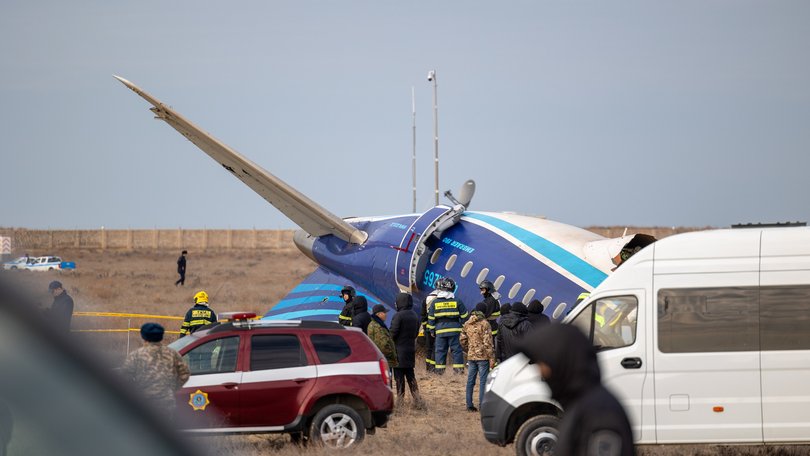LATIKA M BOURKE: MH17 all over again - Did Putin’s regime just down another passenger plane?

It took only hours for Russia to identify what hit the Azerbaijani passenger plane as it approached Grozny, the capital of Chechnya.
Flight J2-8243 eventually crashed near the city of Aktau in Kazakhstan — across the Caspian Sea – in a ball of fire on Christmas morning, killing 38 of the 67 people on board.
“According to preliminary findings, after a collision with a flock of birds, due to an emergency situation on board, the captain of the aircraft decided to divert to an alternative airfield, selecting Aktau as the destination,” Russia’s aviation agency Rosaviatsiya declared.
Sign up to The Nightly's newsletters.
Get the first look at the digital newspaper, curated daily stories and breaking headlines delivered to your inbox.
By continuing you agree to our Terms and Privacy Policy.But as soon as images of the plane’s fuselage emerged open-source analysts quickly noted that the piercings in the plane’s metal could not have been caused by a bird, flock or otherwise, nor could they cause the explosions reported by surviving passengers.
Additionally, Russia’s story failed to accord with Flight Radar data that showed the aircraft was exposed to GPS jamming and spoofing as it tried to land at Grozny and was oscillating for 74 minutes before it crashed at Aktau on the other side of the Caspian Sea after spending two-and-a-half-hours in the air for a flight that normally takes just under 60 minutes.
By Boxing Day the real story became clear.
Azerbaijani officials, cited by local and European outlets said that a Russian surface-to-air missile, specifically the Pantsir system which is used by the Russian military, hit the plane.
Russian forces had been fending off a Ukranian drone attack over Grozny, meaning they may have mistaken the passenger jet for a hostile Unmanned Aerial Vehicle (UAV.)
But this does not explain why the plane was not allowed to land at Grozny after it was immediately hit and had to fly all the way over the Caspian Sea to Kazakhstan.
Azerbaijani media outlet Calibre, the first to report Russia and not birds as the culprit behind the plane’s downing – pondered this exact question.
“Grozny airport refused to allow the aircraft to land,’ Calibre reported.
“Moreover, the Azerbaijani aircraft was also denied landing permissions at the [nearby Russian] airports in Makhachkala and Mineralnye Vody.
“The disoriented crew, subjected to air defence fire and electronic warfare systems, was redirected to the Kazakh city of Aktau.
“It can be assumed that this recommendation was given with one goal: to have the aircraft crash into the Caspian Sea, where all witnesses would perish and the aircraft would sink.
“However, this is merely our assumption.”
That Russia could mistakenly target a civilian plane and possibly exacerbate the loss of human life as part of an attempted cover-up is a scenario all too horribly familiar to the loved ones of the 38 souls who called Australia home before Flight MH17 was shot down out of the sky over eastern Ukraine in 2014.
No Russian has ever been held accountable for the downing of MH17 and Russian President Vladimir Putin has only been emboldened since, annexing Crimea and launching his full-scale invasion of Ukraine eight years later.

Dutch MP Jan Paternotte and leader of the Netherlands Democrats 66 party said Western weakness was letting Putin get away with widespread terror.
“The families of the MH17 victims saw the death of their loved ones followed by only very weak sanctions and even more European dependence on Russian oil and gas,” Mr Paternotte told The Nightly.
“This taught Putin a lesson: that Western countries don’t respond to such an attack with strength, and that the willingness to overlook Russian transgressions goes far.”
Just the start
But the downing of a passenger plane was just the start for the Russians on Christmas Day.
On Christmas morning, Russian forces sent more than 100 drones and 50 missiles Ukraine’s way, targeting energy infrastructure.
“Putin deliberately chose Christmas for an attack. What could be more inhumane?” Ukraine’s President Vololodymr Zelensky said.
And in the Baltic Sea, several data cables were cut including the Estlink-2 power cable which supplies electricity to Estonia from Finland.
The alleged culprit? A Russian-linked vessel flagged to the Cook Islands called Eagle S.
Eagle S is an 18-year-old crude oil tanker which operates as part of Russia’s “shadow fleet” ferrying sanctioned commodities on behalf of Moscow around the world. She had left St Petersburg and was bound for Egypt but Finnish authorities boarded and detained the vessel.
“At this stage, the suspected offence is investigated as aggravated criminal mischief,” Finnish police said in a statement.
It is the third time undersea cables in the maritime region have been cut by ships using a technique called “anchordragging,” whereby an anchor is dropped and dragged across the seabed.
The previous two times Chinese-linked ships were in the area but no government has concluded if the sabotage was deliberate or accidental and if the former, at whose instruction.
Lithuania’s Defence Minister Dovile Sakaliene said it was like an episode of the X-Files.
“Always a ship related to Russia/China [is] always where damage occurs (and) always the faulty anchor,” Ms Sakaliene wrote on X.
“The culprit is hiding in shadows, or rather in shadow fleet and is seeping with Russian oil.”
Estonia, a huge supporter of Ukraine has been previously reluctant to point blame. Its foreign minister Margus Tsahkna recently said in an exclusive interview with Latika Takes: The Podcast that determining culpability was “very hard”.
But the Christmas Day attack triggered a very different response, with the Finnish, Estonians, NATO and the European Commission all issuing statements.
“This is the first time during these incidents where the guilty party – or let’s say a suspect vessel – has been detained in order to conduct investigations,” Estonia’s Prime Minister Kristan Michal told a news conference after breaking holidays to convene his Cabinet.
“Three times in one year, it’s complicated to understand that it’s a random accident,” the country’s Interior Minister Lauri Laanemets added.
Of course, it is prudent to await the outcomes of the investigations.
But the real question relates to accountability. Will Kazakstan and Azerbaijan receive any formal acknowledgement or apology from Russia when, it is likely, to be confirmed as responsible?
How will NATO and other countries hugely reliant on undersea infrastructure for the operations of their economies hold those found to be deliberately sabotaging cables to any account or at the very least find a way to try and deter them?
Because so far, the ledger looks very lopsided and not in the West’s favour.
“By sending almost two hundred projectiles to Ukraine’s cities on Christmas morning, severing sea cables near Finland and downing a passenger plane, Putin has shown what kind of terror Russia is willing to inflict on innocent people,” Mr Paternotte said.
“This time, we need to heed the lessons learned, by recognising that Putin only wants peace when he can’t achieve his aims with war.”

